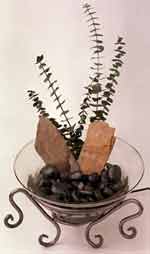Reprinted from the San Diego
Union Tribune
Create a Sea of Tranquility
Soothe Your Soul With
Tabletop Water Fountains
By Amy Stirnkorb
Finding time to relax and unwind can be almost
impossible in today’s hectic world, especially for harried caregivers.
But caring for yourself is as important for your loved ones as it is
for you.
Try a little fountain therapy, for it seems no one can
resist the tranquility simple tabletop fountains can bring to their
lives.
For more than 4,000 years the Chinese, through the art
of Feng Shui, have known about the healing power of water. Feng Shui,
which literally means wind and water, advocates the proper arrangement
of everything in your surroundings , from placement of your furniture
and accessories to water features , to boost your chi', or cosmic
energy.
Turn on a tabletop fountain and you’ve got soothing
surround-sound.
"Fountains can have a calming effect on people
and animals," said Cathleen McCandless, a Feng Shui consultant
in La Jolla, Calif. "It's the presence of water itself that is
the most important component of adding a fountain to one's environment.
Some people enjoy listening to the sound of the water, while others
prefer fountains that do not make any sound as the water flows."
Gina Phillips, general manager of Adelaide's Florists
& Decorators in La Jolla, agrees. "Water is one of the key
things in creating tranquility in your home."
In addition to its calming influence, the hum of trickling
water potentially can mask street noise, help cool your house and humidify
dry air.
Fountains are easy to maintain and use. They don't splash
onto furniture, and they're pretty to look at, Phillips said. "No
real setup is required for a tabletop fountain. Just fill it with water
and plug it in."
Fountains are available online, in mail-order catalogs
and stores of all sorts , from inexpensive models (starting around
$40) at drugstores and discount warehouse clubs to more expensive custom
beauties at specialty shops and decorator stores, where they can cost
hundreds, even thousands of dollars.
"What’s nice is that there are so many different
fountain styles out there that there's something for everybody,"
Phillips said.
If you want to build your own fountain from scratch,
don’t worry. It’s not hard at all, and in the process you’ll
recharge your spirit and inspire the artist-at-heart longing within
you.
You also can share this simple project with your care
recipient who will feel a sense of accomplishment and enjoyment, too.
Fountain basics
There’s really no mystery about how a tabletop fountain works.
Basically, water flows through the fountain via tubing and a pump hidden
neatly in a container.
Start with a small, 120-volt submersible pump that is
virtually maintenance-free and can handle up to 80 gallons of water
per hour. These pumps operate safely around the clock, and many have
adjustable pressure settings that control water flow.
Use distilled water. Remember, too, that you’ll
need to replenish water that has evaporated. Never let the pump run
dry or you’ll ruin it.
And for safety reasons, when assembling your fountain,
carefully position the pump’s cord so water doesn’t drip into
the electrical outlet. A neat trick: Loop the cord below the outlet
so if water does run down the cord, it will drip on the floor.
The next important piece is the container, which for
obvious reasons needs to be watertight. If you find a bowl you want
to use that isn’t water-friendly, no problem. Home improvement
stores carry sealers you apply to the container to waterproof it.
If the bowl’s flaw is a drainage hole in the bottom,
drop in a bathtub or sink stopper, then seal it up with plumber’s
putty.
Generally, your biggest investment will be the pump and
other electrical accessories, such as lights or a mister/fogger.
Most fountain-making supplies can be purchased at garden
centers; home improvement, florist supply and craft stores or online.
Design your own fountain
Starting a design is easy: Let your imagination soar.
If you need a little encouragement, here’s some help.
- Container: Look for a variety of shapes, colors and
sizes. Check out swap meets or thrift and specialty stores. Colleges
also can be a bountiful source of handmade possibilities. If you’re
really crafty and into pottery, make your own container.
- Rocks: Another essential component of tabletop fountains
is adding objects for the water to burble over. But don’t settle
for the first bag of rocks you see. Pebbles, smooth river rocks, glass
marbles, even seashells and sea glass (bits of broken bottles softened
by the pounding surf) are beautiful alternatives to typical stones.
Another option is to skip rocks altogether. Instead, crisscross tiles
of slate and let the water gurgle over them. Or break the slate into
ragged chunks, using some as accent pieces.
- Lighting: If you choose a transparent or translucent
container, underwater lighting can create a dramatic effect as can
crystals, floating candles or misters and foggers.
Consider the out-of-the-ordinary: Why not take a second
look at bathroom or kitchen accessories such as soap dishes, salt and
pepper shakers or mirrors to add to your fountain?
Natural elements, including live plants, plastic or preserved flowers,
driftwood and tree branches such as willow and eucalyptus can add life
to your fountain.
With a little creativity, you’ll bubble over with ideas of your
own.
Whether you buy one or build it yourself, a tabletop
fountain can fill your home with peace and tranquility. What better
gift to give yourself and your loved ones?
Back to the top